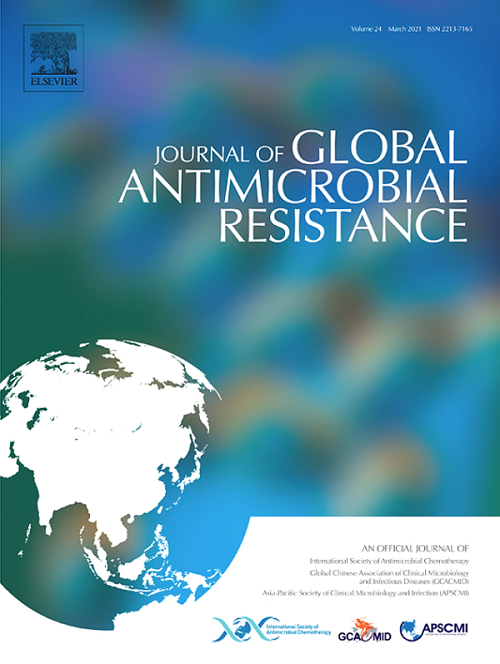从越南胃病患者中分离的新序列型多重耐药幽门螺杆菌菌株的毒力、生物膜形成和抗微生物药物耐药性的基因组见解
IF 3.2
3区 医学
Q2 INFECTIOUS DISEASES
引用次数: 0
摘要
幽门螺杆菌是临床上重要的与胃疾病相关的病原菌。在这里,我们描述了从越南胃炎或胃溃疡患者中恢复的多药耐药幽门螺杆菌新序列类型的基因组。采用E-test对阿莫西林、克拉红霉素、甲硝唑、四环素和左氧氟沙星进行表型药敏试验。重新组装3株幽门螺杆菌的全基因组序列,然后进行多位点序列分型(MLST)、基于核心基因组的系统发育、与毒力、生物膜形成和抗生素耐药性相关的遗传决定因素的计算机分析。幽门螺杆菌基因组序列具有较高的相似性,平均核苷酸同源性(ANI)值为98.5% ~ 99.2%,携带5 ~ 7个致病性岛和3 ~ 6个移动组。菌株的MLST分析显示ST4511、ST4512和ST4513是新的序列类型。基于核心基因组的系统发育显示三个幽门螺杆菌菌株属于亚洲基因型。这些菌株具有128 ~ 131个毒力基因,包括毒素编码基因cagA和vacA。在耐药菌株中检测到pbp1和pbp2双重耐阿莫西林突变,或pbp3突变,23S rRNA基因三重耐克拉霉素突变和gyrA基因左氧氟沙星耐药突变。在甲硝唑耐药菌株和敏感菌株中均检测到rdxA突变,而在甲硝唑敏感菌株中仅检测到frxA突变。最后,在rpoB中也检测到一个利福霉素耐药突变。该研究为越南流行的新型序列型多重耐药幽门螺杆菌菌株的基因组提供了见解,为今后调查其病理生物学和在人群中的传播提供了依据。本文章由计算机程序翻译,如有差异,请以英文原文为准。
Genomic insights into virulence, biofilm formation, and antimicrobial resistance of multidrug-resistant Helicobacter pylori strains of novel sequence types isolated from Vietnamese patients with gastric diseases
Helicobacter pylori (H. pylori) is a clinically important pathogen associated with gastric diseases. Here, we characterized the genome of multidrug-resistant H. pylori strains of novel sequence types, which were recovered from Vietnamese patients with gastritis or a stomach ulcer. Phenotypic-antibiotic susceptibility testing was performed against amoxicillin, clarithromycin, metronidazol, tetracycline, and levofloxacin using an E-test. The whole genome sequence of three H. pylori strains was de novo assembled, followed by in silico analysis of multilocus sequence typing (MLST), core-genome based phylogeny, genetic determinants associated with virulence, biofilm formation, and antibiotic-resistance. The genome sequence of H. pylori strains exhibited a high similarity with the average nucleotide identity (ANI) values of 98.5% to 99.2%, carried 5 to 7 pathogenicity islands, and 3 to 6 mobilomes. The MLST profile of strains revealed novel sequence types ST4511, ST4512, and ST4513. Core-genome based phylogeny exhibited that the three H. pylori strains belong to the Asian genotype. These strains possessed 128 to 131 virulence genes, including toxin-encoding genes cagA and vacA. Double amoxicillin-resistant mutations on pbp1 and pbp2, or a mutation on pbp3, triple clarithromycin-resistant mutations on 23S rRNA gene and a levofloxacin-resistant mutation on gyrA were detected in antibiotic-resistant strains. Mutations on rdxA were detected in both metronidazole-resistant and -sensitive strains, whereas frxA mutations were detected in only one metronidazole-sensitive strain. Finally, a rifamycin-resistant mutation in rpoB was also detected. This study provides insights into the genome of multidrug-resistant H. pylori strains of a novel sequence type circulating in Vietnam for future investigations of its pathobiology and spread through human populations.
求助全文
通过发布文献求助,成功后即可免费获取论文全文。
去求助
来源期刊

Journal of global antimicrobial resistance
INFECTIOUS DISEASES-PHARMACOLOGY & PHARMACY
CiteScore
8.70
自引率
2.20%
发文量
285
审稿时长
34 weeks
期刊介绍:
The Journal of Global Antimicrobial Resistance (JGAR) is a quarterly online journal run by an international Editorial Board that focuses on the global spread of antibiotic-resistant microbes.
JGAR is a dedicated journal for all professionals working in research, health care, the environment and animal infection control, aiming to track the resistance threat worldwide and provides a single voice devoted to antimicrobial resistance (AMR).
Featuring peer-reviewed and up to date research articles, reviews, short notes and hot topics JGAR covers the key topics related to antibacterial, antiviral, antifungal and antiparasitic resistance.
 求助内容:
求助内容: 应助结果提醒方式:
应助结果提醒方式:


